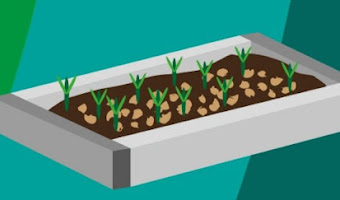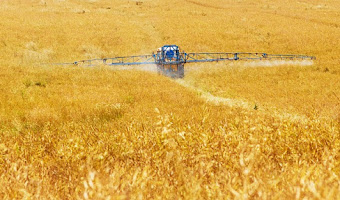Garlic, from the center and south of Asia from where it spread to the Mediterranean area and from there to the rest of the world, has been cultivated for thousands of years. About 3,000 years a. C., was already consumed in India and Egypt.
At the end of century XV the Spanish introduced the garlic in the American continent.
At the end of century XV the Spanish introduced the garlic in the American continent.
TAXONOMY AND MORPHOLOGY OF GARLIC.
- Family: Liliaceae, subfamily. Allioideae.
Scientific name: Allium sativum L.
- Plant: bulbous, lively and rustic.
- Root system: bulbous root, composed of 6 to 12 bulbillos
("cloves of garlic"), gathered at the base by means of a thin film,
forming what is known as "garlic head". Each bulbillo is surrounded
by a white robe, sometimes somewhat reddish, membranous, transparent and very
thin, similar to those covering the entire bulb. From the top of the bulb are
born the fibrous parts, which are introduced into the earth to feed and anchor
the plant.
- Stems: they are strong, of
determined growth when it comes to creeping stems that give the plant an open
bearing, or of indeterminate growth when erect and erect, being able to reach
up to 2-3 meters in height. Depending on the planting framework, they usually
leave 2 to 4 stems per plant. The secondary stems sprout from the armpits of
the leaves.
- Leaves:
radical, long, alternate, compressed and without apparent nerves.
- Stem: It appears through the
center of the leaves. It is hollow, very plump and hairless and grows from 40
cm to over 55, ending with flowers.
- Flowers: are contained in a membranous spathe that opens
longitudinally at the time of flowering and remains withered under the flowers.
They are grouped in umbels. Each flower has 6 white petals, 6 stamens and one
pistil.
Although fertile clones have been identified, the low
percentages of seed germination and seedlings of low vigor make garlic defined
as an obligate apomictic, a term that refers to its ability to produce embryos
without prior fertilization.
SOIL PREPARATION TO GROW GARLIC.
Work should start about six months before planting, they
must leave the ground fluffy and fluffy in depth. They will consist of a deep
plow (30-35 cm) followed by 2 or 3 cross-traces. With this first work will be
buried organic fertilizers.
CULTIVATION OF GARLIC SEEDS.
It is usually done in October or November, although late
plantations are sometimes carried out in late December and early January. It is
carried out in platabandas or in caballeros.
Platabandas: This method is suitable for large crops and for
areas where there are difficulties to practice irrigation (rainfed areas). They
are made with a width of 2-3 m and a separation of 0.7-1 m. The plantation is
carried out in open holes, leaving 30 cm between lines and 20-25 cm between
plants of the same line.
Camellones: it is the system most used and the most suitable
to grow garlic in places with water supply problems. Horsemen can be built with
high moldboard plows or hoes. The width of the furrows will be of 50 cm and the
bulbillos will be planted to 20 cm to each other and to 20-25 cm between lines.
The depth to which they are planted will depend on the size of the bulbillo,
although usually it is of 2-3 cm or 4 at the most.
It can also be cultivated in ruts, bordering the
horticultural crop tables, placed in rows distanced to 12 cm.
WEED CLEANING.
Garlic is a crop that, because of its morphological
characteristics, hardly covers the soil and therefore offers some ease in the
development of weeds and evaporation. It is of the utmost importance to
maintain the clean cultivation of weeds, through appropriate weeding. Manual
weeding is performed or one or more herbicides are applied.
SOIL FERTILIZATION FOR GARLIC CULTIVATION.
On average, in order to obtain 1,000 kg of plant, the
nitrogen requirements, P2O5 and K2O are 2.33%, 1.42% and 2.50%, respectively,
although taking into account the soil fertility, the observed proportions can
be reduced. Mature organic fertilizers should be incorporated evenly in the
field some time before planting. Nitric nitrogen is fractionated in 1-2 times
during the vegetative cycle, otherwise it induces an excessive development of
the leaves to the detriment of the bulbs. The phosphorous fertilizer favors the
conservation of the product.
The cultivation of the garlic thanks the incorporation of
organic material very decomposed. Garlic may be sensitive to the deficiencies
of boron and molybdenum.
GARLIC CULTIVATION IRRIGATION.
Irrigation is not necessary and in most cases can be
considered harmful, except in very dry winters and springs and very loose
terrain.
Irrigation is usually done by spraying or by gravity. The
needs from budding to the beginning of bulbification are the smallest and are
usually sufficiently covered by rainfall. The most important water needs occur
during bulb formation.
During the maturation period of the bulb, the water needs
decrease, until two weeks before harvesting they become null.
Niel and Zunino (1974) established the water needs of garlic
in different areas of France, establishing the global needs of about 2,600 m3 /
ha, to which rainfall must be deducted.
Tuna of garlic and onion (Lita alliela)
Crops it attacks: Garlic and onion.
Description The larvae are approximately 1 cm in length and
light green in color.
Adults are lepidoptera of brown color, approximately 0.5 cm
in length.
Biological cycle
Adults make their appearance in spring. The ovoposición they
effected on the plants attacked that they fan as a function of the temperature
to the 10-12 days.
DAMAGE.
Open galleries on bulbs and leaves. In principle they
usually attack the leaves and then move on to the bulbs. The attacked plants
yellow and die.
GARLIC HARVEST.
In the autumn plantations it takes 8 months to reach the
harvest and 4 months or 4 ½ months on the spring plantations. The humidity of
the soil in contact with the heads already mature causes in the external tunics
blackening and rotting, caused by the action of saprophytic fungi, which
sometimes deteriorate the quality of the harvest.
The right moment of the harvest corresponds to the complete
desiccation of the leaves, making the heads start with good weather. Overtaking
the time of harvest leads to reduced harvest and loss of quality.
On loose ground the bulbs will be unearthed by pulling the
leaves, whereas in compact terrain it is advisable to use tipped shovels or legions.
It is currently harvested mechanically with combine harvesters.
Plucked plants will be left on the ground for 4-5 days
(weather permitting) and then moved in trolleys to sorting and stranding
warehouses. As the bulbs are being collected, the soil must be cleaned.
If the collection is destined for the seed, the harvesting
is done with the fully mature plant. After collection and during the selection
period, the best shaped, healthy bulbs and those that fully respond to the
characteristics of the cultivated variety will be removed. Then they will be
straightened and the strings will be placed indoors, in a place well dry and
ventilated. To plant one hectare, about 700 kg of bulbs are needed.
BENEFITS OF EATING GARLIC.
Garlic is very effective in the fermentative processes of
the intestine, with accompanying flatulent phenomena and spasmodic pains. It
also acts as a vasodilator and relaxant. The vessels, especially those of the
legs but also those of the fundus of the eye and of the brain, dilate so that the
tissues receive a better feed and thus prevents a premature aging. It also
serves for the prevention and treatment of aging processes of the vascular
system (arteriosclerosis) and to strengthen the treatment of sleep
disturbances, hypertension, general weakness and decreased perform.
Other articles that will surely interest you:
- Formula matemática para calcular la aplicación de fertilizantes químicos
- Cuáles son los nutrientes más importantes para las plantas de nuestro huerto - usos y propiedades
- Como procesar semillas artesanales para el huerto
- Composición de la población biológica del suelo
- Como construir sistema de riego casero por goteo para nuestro huerto






